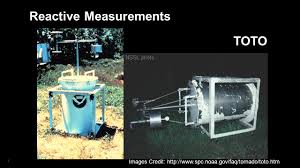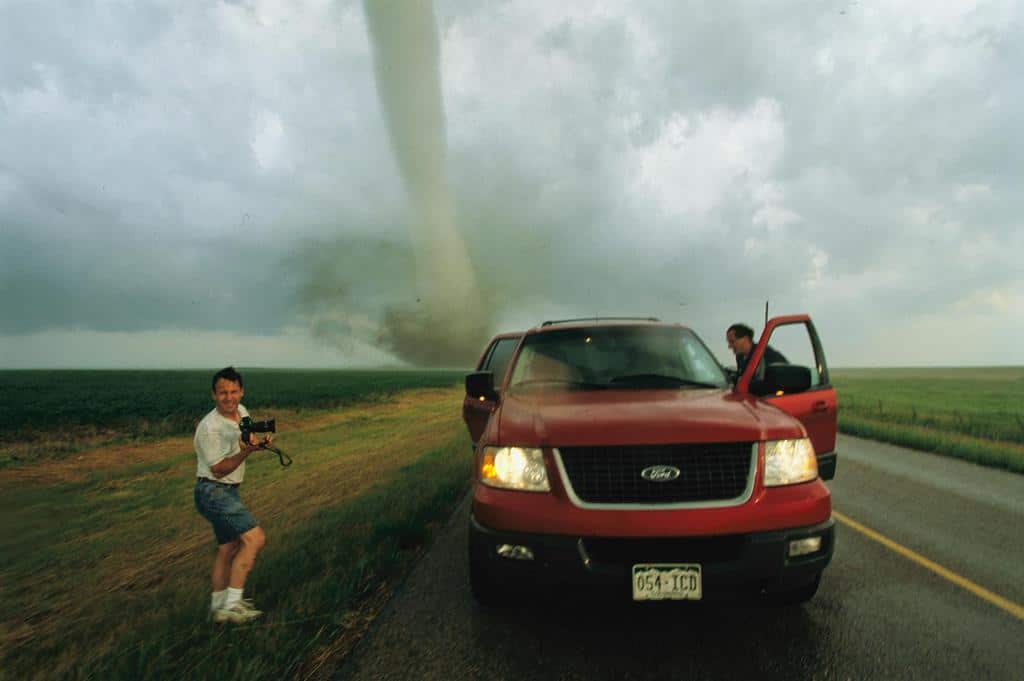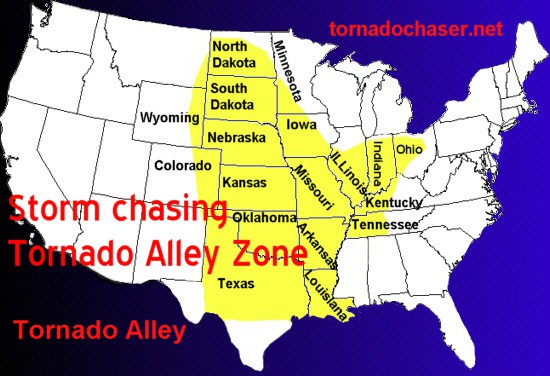
The movie Twister,© which was filmed in and around Ames, Iowa, was nominated for 2 Oscars, 13 other awards and won a total of 10 awards. “Bill and Jo Harding, advanced storm chasers on the brink of divorce, must join together to create an advanced weather alert system by putting themselves in the cross-hairs of extremely violent tornadoes.” (Plot summary, IMDB.com).

Their team of storm chasers, competing against a better-funded team, are trying to create a device meant to be released into a tornado. The plot is a dramatized view of research projects like Verification of the Origins of Rotation in Tornadoes (VORTEX) of the National Oceanic and Atmospheric Administration (NOAA). The device used in the movie, named “Dorothy,” is copied from “TOTO” (TOtable Tornado Observatory)- the real device used in the 1980s by the National Severe Storms Laboratory (NSSL). Dorothy (i.e. TOTO) was an instrument designed to be placed in the path of a tornado, and then sucked up into the tornado. When TOTO was sucked into the tornado, sensors would be released and these sensors would measure, among other things, pressure and humidity. Unfortunately, TOTO was too light and fell over when it was sideswiped by the edge of tornado. It was later deployed as a portable weather station to measure thunderstorm gust fronts and non-tornadic mesocyclones.
VORTEX was designed to answer questions about the causes of tornado formation. It documented the entire life cycle of a tornado from beginning to end, for the 1st time in history. VORTEX2 has many more instruments than the original VORTEX and is now mobile. Currently, in 2016, NSSL researchers are embarking on VORTEX Southeast. With this research, scientists seek to understand the environmental forces in the southeastern United States – studying the intensity, structure, and path of tornadoes in the region.

What does it take to be a storm chaser? Anyone can become a storm chaser – there are no procedures, certifications or permits required unless you want to become a SKYWARN® spotter.
SKYWARN® is a National Weather Service (NWS) volunteer program with between 350,000 and 400,000 trained severe weather spotters. The main responsibility of a SKYWARN® spotter is to identify and describe severe local weather and storms. They are different than chasers, usually staying in one place to observe, until it is necessary for them to move. Their training includes learning about basic severe weather structure and development, how to report, and basic severe weather safety. If you are interested in becoming a SKYWARN® volunteer, training is free and typically lasts about 2 hours. Check SKYWARN training for information and find the closest SKYWARN® program in Iowa!

Storm chasing is an expensive as a hobby – mainly because it involves a lot of travel. The term “chaser” refers to the careful forecasting and tracking of storms and then going to those storms to make observations. Many chasers have to drive or fly to “tornado alley,” stay in hotels, and can drive over 500 miles in a single chase day, all of those expenses add up to be pretty costly
If you do decide you want to venture out on your own to watch a storm, you must be very careful – not only because of the storm, but also because of the other chasers in the vicinity. Often amateur storm chasers will park in the middle of a road to watch and photograph the approaching storm. Parking in the middle of the road makes it nearly impossible for vehicles to leave the potential danger zone and they are often in the way of the trained and seasoned storm chasers. In some locations it has been reported that as many as 100 amateur storm chasers may all converge in an area where the chance for tornadoes is high.
Storm chasing is dangerous – even for the seasoned chasers. In May, 2013, 3 chasers and 1 civilian were killed by tornadoes near El Reno, OK. Local resident, Richard Henderson, was killed when he decided to follow that storm. Tim Samaras (a chaser and a meteorologist), his son Paul Samaras, and Carl Young were experienced, seasoned chasers and considered to be the safest storm chasers at the time. Tim founded and headed the Tactical Weather-Instrumental Sampling in/near Tornadoes EXperiment (TWISTEX). The TWISTEX vehicle in which the three were chasing was struck by a violent wedge tornado with winds up to 295 mph.
If you are intrigued by the idea, but don’t feel up to chasing on your own, you can actually be a “tornado tourist.” A 10-day, professional storm chasing tour (sometimes called “tornado safaris”), typically costs between $2000 and $3000. That includes lodging and fuel costs…
For a fascinating look at the personal stories and experiences of a storm chaser, check out Out of the blue : a history of science, superstition, and amazing stories of survival by John s. Friedman.
For more information about tornadoes and severe weather, check our blog, “Stormy Weather,” from April 29, 2016.
Interesting Twister© facts:
Twister© is the 1st Hollywood feature film to be released on DVD and one of the last to be released on HD DVD. It has since been released on Blu-ray.
Both Bill Paxton and Helen Hunt were temporarily blinded by bright electronic lamps used to get the exposure right for the dark, stormy sky. They also both had to have hepatitis shots after filming in an unsanitary ditch.
If you live in the tornado alley and are up for some excitement – you just might want to watch Twister©! Even if you don’t live in tornado alley, you should get some popcorn and watch, and learn about storm chasing!
Resources:
Twister (1996 film). Produced by Steven Spielberg’s Amblin Entertainment.
Horvitz, Leslie Alan. 2007. The essential book of weather lore : time-tested weather wisdom and why the weatherman isn’t always right. Pleasantville, NY : Reader’s Digest Association. Engineering Library QC995.4 .H665 2007
Mogil, H. Michael. 2007. Extreme weather : understanding the science of hurricanes, tornadoes, floods, heat waves, snow storms, global warming and other atmospheric disturbances. New York, NY : Black Dog & Leventhal Publishers : Distributed by Workman Pub. Co. Engineering Library QC981 .M65 2007
Svenvold, Mark. 2005. Big weather: Chasing tornadoes in the heart of America. New York : Henry Holt. Engineering Library QC955.5 U6 S75 2005
The TOTO Home Page. Storm Prediction Center. Date Accessed May 9, 2016.
Weather Library > Storm Chasing: Frequently Asked Questions. Dan Robinson, Storm Chaser/Photographer. stormhighway.com
What is VORTEX2: Verification of the Origins of Rotation in Tornadoes Experiment. VORTEX@NSSL. Date Accessed May 4, 2016
National Weather Service SKYWARN™ February 29, 2016. NOAA National Weather Service.
Storm Chaser Tim Samaras: One Year After His Death, His Gift is Unmatched. By Robert Draper, for National Geographic. May 27, 2014. National Geographic.
TWIRL – Tornadic Winds : In situ and Radar observation at Low levels. 2016. Center for Severe Weather Research.
Tornado Alley. NOAA National Centers for Environmental Information. Date accessed, May 9, 2016
NSSL The National Severe Storms Laboratory.
Other Resources:
The Online Tornado FAQ. Storm Prediction Center. Date Accessed May 9, 2016
Storm Chasers Tim Samaras, Paul Samaras and Carl Young Killed in Oklahoma Tornadoes. June 2, 2013, by Leezel Tanglao. ABC News
Tornado Chaser Tim Samaras Killed: Fans Pay Tribute. June 3, 2013, By Melody Kramer. National Geographic.